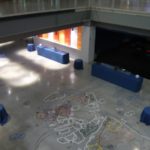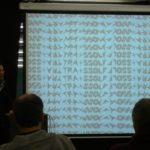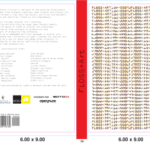interpunctie samples all.pdf
From Thursday 20th to Sunday 23rd November OSP went to contemplate the Bolwerk archives landscape from the window of Frans Masereel Centrum. As part of Bolwerk‘s residency, we were invited to propose a reading of Bolwerk’s material inbetween its punctuation. Linked to our actual and future projects, this journey also presented itself as a good start to investigate archive visualization/schematics and digest. We arrived with a proposal focussing on tools development, bases of an archives blender, a small chain of automatic process.
On the spot, in the plastic yurt heated by a wood-burning stove, we discovered 87000+ files on the Bolwerk nas harddrive. All our sources (scripts, tests, drawings and pictures) are gathered in this public git repository. In the current documentation text, you can find links to readable files and preview of the result.
To have an overview of all the digital archives, we first built 4 bash scripts going through the directories looking on 4 criterias:
– time scale
– number of files
– size of the files
– filetypes
From this, we get a text output already drawing a first visual landscape, see landscape-saturday.csv
Then, in a graphic translation attempt, we started a plotter script, to plot this landscape into visual/graphic shapes. Is it the rotary structure of the physical archive in the yurt, or our temporary traveler status here that resonate with Bolwerk’s seems permanent one? It’s not clear but we had this idea to draw the directories as bags, attributing one parameter to their description elements.
– width : time scale
– height : number of files
– colors of the bag : filetypes
– roundness : size of the files
See plot4.svg (in /plotter directory).
The shapes are distributed along the timeline from left to right (1997-2011). The most large they are the more the files and directories they contain, the vertical piling was defined by the browsing order. The archives has been clearly compiled with 2 past periods of grouping, and a more regular the lasts years (as many archiving of digital files travel from one kind of media to another).
![]() This attempt to draw the landscape with differents bags, raised again questions that were floating around us for a while. How to shape the bags/directories, can we avoid the designer/developer dichotomy (starting from an arbitrary symbol/drawing / from an arbitrary process)? Plot only the dots contained in the files in the directories, as a free interpretation of the screening process present in different place in this graphic farm and in answer for the astonishingly new question from Marthe for us “how the shape of the dot vary with fonts”? Or the files as dots? Why are we somehow reluctant to visualize the data of the archives? After years of Edward Tufte impact on some of us and on the field, is it linked to Ted Byfield’s conference in Tel Aviv where he develop some aspects of its critics, or the approximation found at middle page and elsewhere, or around that article or these pamphlets about visualization? Is the muted but even more palpable and strong influence, here at the wood cutting Masereel mansion, of the Isotype system from the team Neurath/woodcutter Arntz and particulary the transformation of complex source information into a sketch for a self-explanatory chart, mainly by the transformer Marie Reidemeister?
This attempt to draw the landscape with differents bags, raised again questions that were floating around us for a while. How to shape the bags/directories, can we avoid the designer/developer dichotomy (starting from an arbitrary symbol/drawing / from an arbitrary process)? Plot only the dots contained in the files in the directories, as a free interpretation of the screening process present in different place in this graphic farm and in answer for the astonishingly new question from Marthe for us “how the shape of the dot vary with fonts”? Or the files as dots? Why are we somehow reluctant to visualize the data of the archives? After years of Edward Tufte impact on some of us and on the field, is it linked to Ted Byfield’s conference in Tel Aviv where he develop some aspects of its critics, or the approximation found at middle page and elsewhere, or around that article or these pamphlets about visualization? Is the muted but even more palpable and strong influence, here at the wood cutting Masereel mansion, of the Isotype system from the team Neurath/woodcutter Arntz and particulary the transformation of complex source information into a sketch for a self-explanatory chart, mainly by the transformer Marie Reidemeister?
Looking to it as a landscape in a contemplative way, looking at the hard-drive in a calm way, different for an top/down approach of some past anthropological pseudo-objectivity or burning with some efficiency in mind, by practicing it like to roving some paths in the forest? Because we feel that practicing the data, chewing it up, became part of it as in any quantum experience was the only way to try to balance a bit the asymmetric and problematic relationship that we can have with a 14 years archive of a multi-crossed-mono-person-organisation (and that we dare to link with Roy Wagner, à propos des relations initiales avec les Daribi de la Nouvelle-Guinée, “leur façon de ne pas me comprendre n’était pas la même que celle que j’avais de ne pas les comprendre” maybe also because our permanent cross-lingual during that residency, which shape also deeply the incorrect writing of the current post).
Our favorite atomic bricks, fonts and her quarks glyphs, and more precisely fonts contained in the pdfs contained in the archive, appears to be possible candidates to bootstrap us from the wood smoke. An excavator is added, the fonts resulting of that operation shows how different applications embed and subset fonts when exporting pdfs. By counting the fonts, merging the fonts that are each directory, based on glyph missing, producing the digital upper-and-lower-cases of Bolwerk.
As a last detour we plotted the samples collection through Scribus outlined pdf, see plotter/samples, like an echo to decrypt from a certain today in the fiction of being already in the future.
– samples_all_outlined.pdf (all the chars of the merged fonts – 458 pages)
– interpunctie_samples.pdf (all the periods of the merged fonts on one sheet)
– interpunctie_samples_all.pdf (more interpunction)
– and interpunctie_all_esthetified.pdf for which Gijs write us as a temporary end dot: “I’ve put some thought into that name. It felt like a bizarre act / twist:to just center the text out of aesthetic considerations. After such a rough process.”
More from my site
git clone git://git.constantvzw.org/osp.residency.masereel








